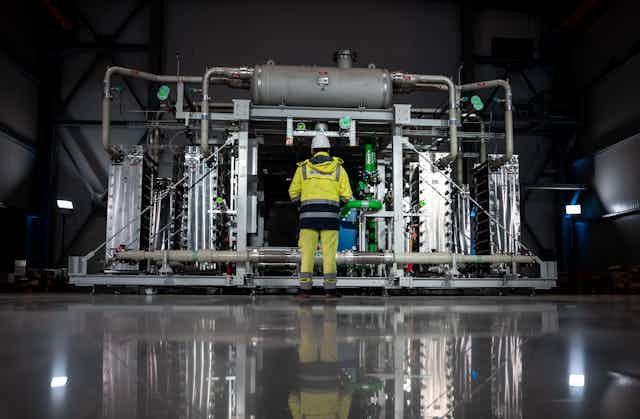Hydrogen can play a key role in Australia’s energy transition by giving us additional ways of storing and moving energy around. As the world shifts towards cleaner energy production, there’s a push to make hydrogen production cleaner as well. In Australia, low-emission hydrogen is produced in two main ways.
One method produces what is known as “green hydrogen”. It uses electricity produced from renewables – such as solar, wind or hydro – to “crack” water into separate streams of hydrogen and oxygen.
The other method produces “blue hydrogen”. This process separates the hydrogen from a gas mixture obtained from fossil fuels (coal or natural gas), using carbon-capture technologies to deal with the emissions.
While different colours are used to describe these methods, the resulting product is the same: colourless hydrogen. Both methods are technically viable options.
So, we wanted to know what the public thinks about these approaches. Understanding people’s attitudes in more detail will help scientists, industry and governments to develop hydrogen technologies in a way that aligns with community values and expectations.
Our survey found only a slight difference in public attitudes to the two methods when they were described without the colour “labels”. The method of production had little impact on people’s willingness to accept different uses of hydrogen.
Why do we need to know what people think about hydrogen?
There is a focus on scaling up the hydrogen industry for many purposes, including transport, heating and industrial uses, in Australia and overseas.
Although there are plans for many new uses, such as powering vehicles, hydrogen has had industrial uses for a long time. At present, it’s mainly used to make other chemicals, such as ammonia for nitrogen fertiliser. However, most of this hydrogen is produced globally using fossil fuels, which emits carbon.
Now attention has turned to producing low-emission hydrogen. Past research has shown Australians are “cautiously optimistic” about hydrogen’s potential as a future fuel. We wanted to explore attitudes to the two low-emission production methods more closely.
Understanding public attitudes is key to promoting responsible innovation for the benefit of all Australians.

Read more: Why electric trucks are our best bet to cut road transport emissions
How was the survey done?
We asked a representative sample of 1,900 Australians to share their thoughts about living near a hypothetical hydrogen hub – a site where hydrogen is stored, transported and used locally. Participants were told the hydrogen would be produced nearby (200 kilometres away).
We wanted to investigate the effect of the “green” and “blue” production methods on acceptance. To avoid introducing bias, we only explained the technical process of each production method. We did not describe them using colours. Half of the participants were told the hydrogen was produced using one method and half were told about the other method.
Because many Australians aren’t aware of hydrogen technologies, we consulted technical experts here at CSIRO so we could provide relevant information about the production methods and their potential impacts. Participants were also shown a short video introduction to hydrogen (shown below) at the start of the survey.
We then asked a serious of questions to assess beliefs, attitudes and levels of support for the production methods and various uses of hydrogen.
A slight preference for ‘green’
Participants who were told the hydrogen was produced using renewable energy – “green” hydrogen – had, on average, a more positive attitude to it than those presented with hydrogen made from fossil fuels with carbon-capture technology – “blue” hydrogen. However, the difference between the two groups’ overall appraisal of the production methods was quite small.
We also explored the beliefs that underpin these attitudes. Despite some differences in beliefs between the two groups, many of these differences were again quite small. And there were no differences in the perceived influence on cost of living and wealth creation.
The largest difference between the groups was the perceived replaceability of the technology. Blue hydrogen was seen as the more replaceable approach. People also reported blue hydrogen as having a worse impact on climate change and competing more with renewable electricity production.

What is the impact on acceptance of hydrogen?
The small differences of opinion about production methods had little influence on people’s willingness to accept different uses of hydrogen. For example, knowing a bus was fuelled by blue hydrogen had a relatively weak effect on how willing people said they’d be to use a hydrogen bus. For most hydrogen applications presented, support was quite neutral regardless of how it was made.

Further analysis showed that people with stronger pro-environmental attitudes were more supportive of green hydrogen. Those with weaker pro-environmental attitudes were more supportive of blue hydrogen.
These results suggest that, to some extent, people’s broader worldviews shape their evaluations of production methods. Although blue hydrogen aims to address carbon emissions, it seems those who strongly value environmental preservation see blue hydrogen as less likely than green hydrogen to achieve this goal.
Read more: For Australia to lead the way on green hydrogen, first we must find enough water
Neither method is strongly opposed
Our research shows there is no strong opposition to either hydrogen production method at this stage.
Results suggest the hydrogen industry will need to address concerns that blue hydrogen technology might need to be replaced sooner rather than later. There is also a need to be clear about its impact on the environment and potential to compete with power from renewables.
Despite these concerns, it seems the production method is not holding back hydrogen acceptance at this stage. As the industry grows, current public beliefs suggest it will be increasingly important to demonstrate that using hydrogen is safe and effective, and won’t compete with other renewable energy technologies.

